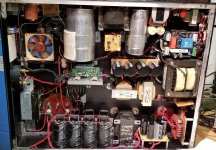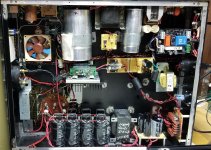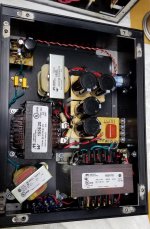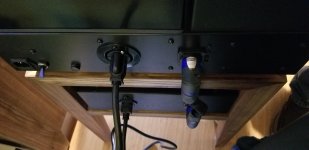:
Bad multimetr : D
According to the Monolith Magnetics S-833 datasheet, secondary resistance for the 4 ohm tap is 0.112 ohms.
According to the Monolith Magnetics S-833 datasheet, secondary resistance for the 4 ohm tap is 0.112 ohms.
So much better :sax
Well, after 7 years of hard labor, the pass MOSFET on the bias-setting shunt regulator under the 833C tube of my left amp gave up the ghost. I'm running it pretty hard under the 833C so I'm not really surprised. Shorted D-S. Bummer...BUT from lemons comes lemonade!
Since I have to lug the amp down to the basement (with help - definitely a 2-person job) to fix the MOSFET, I will take this opportunity to finally pull the 833C filament and 6E5P heater supplies out of the amp chassis and put them in a separate box - I bought Landfall boxes and all the parts for this several years ago and never got around to doing it; now I might as well follow-through. This ought to give me a quieter amp due to moving the 10V, 10A filament power supply and allow me to use a proper 20A first choke instead of the buzzing, noise-spewing 10A choke I was using (the 20A unit wouldn't fit in the box!). A side benefit is the behemoth will be 20-25lbs lighter...every little bit helps.
While I'm at it, I'm also upgrading the pass MOSFET to an IXYS HiPerFET IXFR48N60P. It's a 600V, 32A piece with 300W power dissipation (vs 190W for the current FET) and is in the Isoplus247 electrically isolated back surface package so I can just bolt it to the chassis heat sink instead of needing a SilPad, thus facilitating the heat dissipation a bit. This should help to bullet-proof this "weak link" in the system.
Stay tuned, this could take a while...
Since I have to lug the amp down to the basement (with help - definitely a 2-person job) to fix the MOSFET, I will take this opportunity to finally pull the 833C filament and 6E5P heater supplies out of the amp chassis and put them in a separate box - I bought Landfall boxes and all the parts for this several years ago and never got around to doing it; now I might as well follow-through. This ought to give me a quieter amp due to moving the 10V, 10A filament power supply and allow me to use a proper 20A first choke instead of the buzzing, noise-spewing 10A choke I was using (the 20A unit wouldn't fit in the box!). A side benefit is the behemoth will be 20-25lbs lighter...every little bit helps.
While I'm at it, I'm also upgrading the pass MOSFET to an IXYS HiPerFET IXFR48N60P. It's a 600V, 32A piece with 300W power dissipation (vs 190W for the current FET) and is in the Isoplus247 electrically isolated back surface package so I can just bolt it to the chassis heat sink instead of needing a SilPad, thus facilitating the heat dissipation a bit. This should help to bullet-proof this "weak link" in the system.
Stay tuned, this could take a while...
Here is my crude way to get 10 Volts 10 Apps DC for 833A

I keep the 4.5 Farad capacitor pre-charged with a 9 Volt wall wart through a 100 Ohm resistor so the rest of the system is not damaged by the extreme inrush it would take to charge it from zero when turning on the cathode heater for the 833A. This has worked for several years with no sign of strain and this is what it takes to have enough simple filtering for the pure DC the tungsten filament requires to prevent hum in the speakers.
I keep the 4.5 Farad capacitor pre-charged with a 9 Volt wall wart through a 100 Ohm resistor so the rest of the system is not damaged by the extreme inrush it would take to charge it from zero when turning on the cathode heater for the 833A. This has worked for several years with no sign of strain and this is what it takes to have enough simple filtering for the pure DC the tungsten filament requires to prevent hum in the speakers.
Ifanyone has tried it let us know how it worked. The important thing is the DC has to be very pure. Also. I run my 833A's at zero grid bias and 1000 Volts on the plate through a Hammond 1642SE output transformer which is good for 300 ma. The 833A draws about 120 ma at zero grid bias and 1 kV on the plate. The grid is driven by a transformer which runs a 45 through 5 k Ohms and outputs 600 Ohms between one side of the 833A cathode and the grid, eliminating anything from the signal path. Sowter makes a headphone output transformer which should work and so does Lundhal
OK, the left amp is done. The entire 833C filament supply pre-regulator and 6E5P heater supply are now in the new box, connected to the amp via 4-pole right angle speakon connectors. I also moved the fan transformer and PS to where the filament supply was previously, and went to a split-bobbin transformer on the fan to keep as much fan hash out of the AC supply as possible. I still need to make a shorter power cord to connect the two boxes, but for now I'm using a spare power cord I had lying around.
It all fires up nicely and is dead quiet, even ear to the drivers quiet; previously you could hear some buzz with ear to drivers but not any more. Obviously the 10A filament supply was coupling to the OPT when they were both in the same box. Also, the physical buzz from the too-small first choke is completely gone with the new 20A choke in place.
I will make some measurements later but my ears tell me this is well worth the work.
First pic is the amp pre-mods, second is post-mods.
Now on to the right amp!
It all fires up nicely and is dead quiet, even ear to the drivers quiet; previously you could hear some buzz with ear to drivers but not any more. Obviously the 10A filament supply was coupling to the OPT when they were both in the same box. Also, the physical buzz from the too-small first choke is completely gone with the new 20A choke in place.
I will make some measurements later but my ears tell me this is well worth the work.
First pic is the amp pre-mods, second is post-mods.
Now on to the right amp!
Attachments
Here's a pic of the inside of the new PS box and a shot of how it's all connected up in my listening room. I put a switched AC outlet on the back of the amp to supply the AC to the new PS box when the amp is switched on, so no extra switches to throw, and still using the same soft-start board in the amp.
Attachments
I use a Hammond 10 Volt transformer rated at 20 Amps a heat sinked rectifier rated at least to 50 Amps, a 82,000 micro-Farad first capacitor, 0.1 Ohn 25 Watt wire-wound finned resistor and the final capacitor a car stereo "digital" 4.5 Farad capacitor. This capacitor needs to be pre-charged which I do with a 9 Volt wall wart through 100 Ohm resistor. I leave the wall wart on when the amplifier is not in use and I wire in a relay to disconnect it from the cathode when the system is turned off in order not to discharge the 4.5Farads. This has been working for over two years.Leaving the wall wart on takes about 15 cents a month worth of electricity.
This is probably cruder than some regulated systems but you have to use pure DC to heat tungsten cathodes or they make the loudspeakers hum.
This is probably cruder than some regulated systems but you have to use pure DC to heat tungsten cathodes or they make the loudspeakers hum.
The Coleman regulators I prefer for DHTs have proven to be extremely reliable and significantly better performers that the brute force methods described. (I've used those too.) I've used dozens in my builds for over a decade, and so far have seen just one with an intermittent pot.
I use LT1083/4/5 depending on load current as regulators for idh tubes and as pre-regulators for the coleman. I've not had one failure in over 20 years with those.
I have seen rectifiers and electrolytics fail in filament heating service, but again that's been extremely rare. (I think I have had one rectifier failure and have fixed a number of commercial units that had shorted filament rectifiers.)
I use LT1083/4/5 depending on load current as regulators for idh tubes and as pre-regulators for the coleman. I've not had one failure in over 20 years with those.
I have seen rectifiers and electrolytics fail in filament heating service, but again that's been extremely rare. (I think I have had one rectifier failure and have fixed a number of commercial units that had shorted filament rectifiers.)
Cool, sounds like a worthwhile improvement was the result. I am also chasing these sorts of issues in my own amplifiers which are a whole lot less ambitious than the midlife crisis..
Definitely worthwhile. I have had all the parts including the Landfall boxes for 6 years waiting for something to break to give me a reason to have to lug those monsters to my basement workshop. That happened last month when a mosfet in the cathode regulator died, so I was out of excuses! ;-)
The Coleman regulators I prefer for DHTs have proven to be extremely reliable and significantly better performers that the brute force methods described. (I've used those too.) I've used dozens in my builds for over a decade, and so far have seen just one with an intermittent pot.
I use LT1083/4/5 depending on load current as regulators for idh tubes and as pre-regulators for the coleman. I've not had one failure in over 20 years with those.
I have seen rectifiers and electrolytics fail in filament heating service, but again that's been extremely rare. (I think I have had one rectifier failure and have fixed a number of commercial units that had shorted filament rectifiers.)
Same here, two parallel Coleman V4s feeding the filaments in my amps. I prefer choke input LCLC supplies for smooth DC without cap-input spikes, and I think they help prolong the life of rectifiers, caps and regulators for that reason. Lots of iron and weight is the price to pay, pick your poison.
- Home
- Amplifiers
- Tubes / Valves
- The Midlife Crisis - My 833C Amp Build



